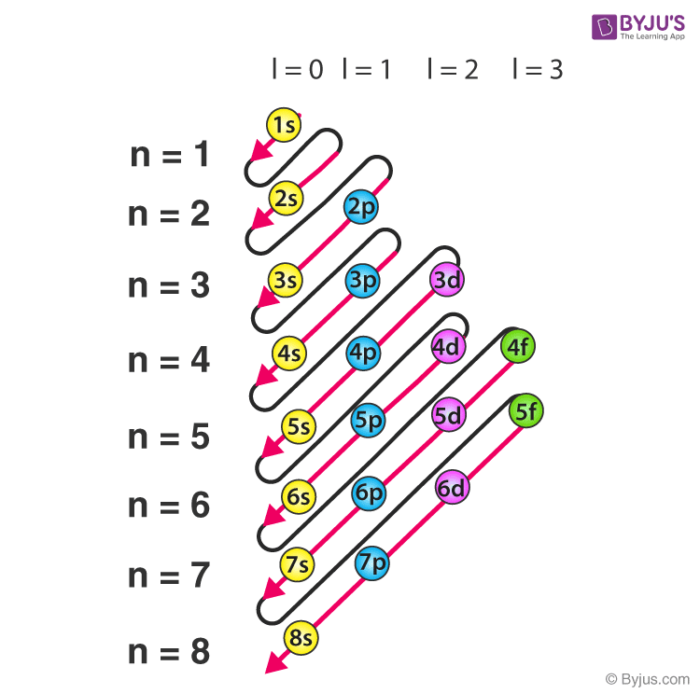Electron configuration:
Note: Shells use the formula $2n^2$ as the total possible electrons that can be stored in that shell, where n represents the energy level notation.
e.g. Calcium's electron configuration would be $2,8,8, 2$.
Period number is equal the the electron shell that an element's valency electrons occupy. E.g. in period 2, the valence electrons are on the n = 2 shells.
Groups have the same valence electron number, and this will dictate their chemical properties / the ways they bond.
Note: They are similar but not the same. Some are more/less reactive than others.
Most elements will try to reach stability of nearest noble gas.
E.g. Potassium has an electronic configuration of $2,8,8,1$, it will achieve stability by losing electrons to have the electron configuration of its nearest noble gas (Argon).
As you go lower on a group, elements get more reactive.
This is because attraction to nucleus is lower as the number of shells increase (and the distance from the energy levels and nucleus increases).
To become an ion you require ionisation energy.
Ionisation energy is needed to break the attraction between an electron and its nucleus, so the further away an electron is from its nucleus the weaker the attraction force, and thus less ionisation energy is required to ionise.
Thus, elements in higher periods are more reactive.
Therefore, elements in higher periods have lower ionisation energy.
Non-metals typically gain electrons.
Typical behaviour of group 7 (non-metals) is to gain electrons.
Check for diatomic molecules!!
e.g.
$Cl_{2}+ 2\bar e \rightarrow 2Cl^-$
What is charge of nitride
Nitrogen has an electron configuration of $2,5$. Therefore, if it wants to reach stability via its nearest noble gas (Neon), which has an electron configuration of $2,5$, it must gain 3 electrons, becoming negative.
$N_{2}+ 6 \bar e \rightarrow 2N^{-3}$ - this is the reduction reaction for nitrogen. redox be like
The actual electron description formula (?) is:
$N+ 3 \bar e \rightarrow N^{-3}$
Note here we are simply describing the redistribution of electrons for one nitrogen atom. Realistically, if this were to happen in nature it would involve 2 atoms, as Nitrogen is diatomic.
Because nitrogen has a smaller atom, and when nitrogen gains electrons, the nucleus's attraction to the electron will be stronger than, for example, phosphorus, as the nucleus' attractive force will be stronger as distance decreases.
Principle quantum number is the term for n.
A new energy level of shell is started at the beginning of each new Period.
Period number is the principle quantum number of the shell being filled.
Group number is the number of electrons in the outer shell. (somewhat, not including the transition metals)
Subshells - Electronic Configuration:
Electrons are arranged in energy levels or shells
Energy of shells increases as distance from nucleus increases.
n is the principle quantum number which shows energy
The maximum number of each shell is $2n^2$
Shells are divided into sub-shells.
n = 1 has a single s subshell
n = 2 has s and p subshells
n = 3 has s, p and d subshells
The subshells are:
s, p, d, f
The 's' subshells holds a maximum of 2 electrons.
The 'p' subshells holds a maximum of 6 electrons.
The 'd' subshells holds a maximum of 10 electrons.
The 'f' subshells holds a maximum of 10 electrons
https://byjus.com/chemistry/aufbau-principle/

e.g. Hydrogen in spdf notation:
$_1H$ $1s^1$
here, the first 1 is the principle quantum number (energy level). In this case, its n = 1.
's' represents the name of the subshell
The second 1 represents the number of electrons in this subshell.
e.g.
Lithum is $1s^22s^1$
e.g. Berylium is $1s^22s^2$
What is the energy levels configuration of Aluminium?
Aluminium's atomic number is 13, so 13 electrons.
In energy levels configuration, that's 2, 8 , 3.
In spdf notation, its $1s^22s^22s^22p^63s^23p^1$
Remember! Principle quantum number for each subshell!
Calcium: 20 electrons: 2, 8, 8, 2
$1s^22s^22p^63s^23p^64s^2$
How to check: Count all electrons! :)
Calcium ion ($Ca^{2+}$):
$1s^22s^22p^63s^23p^6$
Argon:
$1s^22s^22p^63s^23p^6$
Research isoelectronic species - same electron configurations
Isoelectronic species:
To have the same number of electrons or the same electronic structure.
Essentially, its when two or more molecules have the same structure and electronic configuration, but differ by elements.